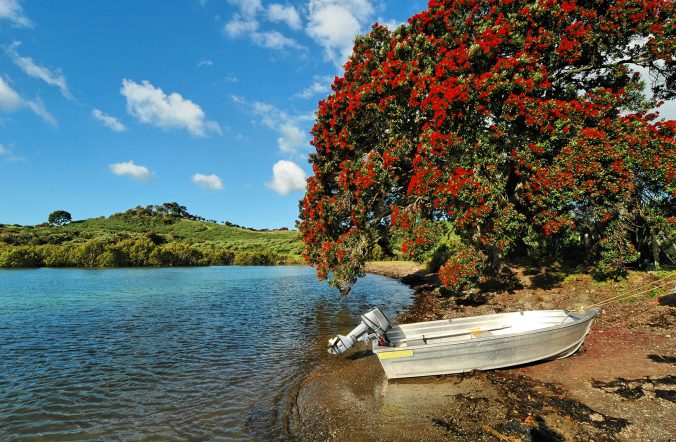The pōhutukawa is one of twelve Metrosideros species endemic to New Zealand and has an important place in New Zealand culture for its strength and beauty.
The pōhutukawa (Metrosideros excelsa), is New Zealand’s most colourful flowering tree. Its canopy bursts into a sheet of brilliant crimson red (or occasionally orange, yellow or white) blossom in early summer, which earns it the alternative name of New Zealand Christmas Tree.
Pōhutukawa is a coastal evergreen tree in the myrtle family, Myrtaceae and it found on the Northern half of the New Zealand ‘s North Island, evergreen coastal forest and scrubland on rocky bluffs and beach dunes. Pōhutukawa is reduced to a shrub by exposure on sea cliffs. Stretches of steep coastline, such as in the Bay of Islands, are famed for the massed flowering of wind-shown pōhutukawa.
As with the Eucalyptus and Callistemon genera – which are also members of the myrtle family, though not close allies of Metrosideros – the pōhutukawa’s vivid display comes from its flowers’ long mass of stamens, which attract birds and insects as pollinators. Pōhutukawa has glossy, leathery leaves, and interesting aerial roots used to build in extra support as they drop from the branches to the ground and take root.
The pōhutukawa’s vivid display comes from its flowers’ long mass of stamens, which attract birds and insects as pollinators.
The pōhutukawa is one of twelve Metrosideros species endemic to New Zealand. Renowned for its ability to survive even perched on rocky, precarious cliffs, it has found an important place in New Zealand culture for its strength and beauty. The genus consists of about 50 species, mainly scattered throughout the Pacific Islands as far east as Hawaii and the Marquesas.
In New Zealand, pōhutukawa trees are under threat from browsing by the introduced Australian brushtail possum. A charitable conservation trust, Project Crimson, is charged with reversing the decline of pōhutukawa and other Metrosideros species – its mission statement is “to enable pōhutukawa and rata to flourish again in their natural habitat as icons in the hearts and minds of all New Zealanders”.
Pōhutukawas are popular in cultivation. Its toughness in extreme coastal conditions has made it a favourite tree for seafront plantings in frost-free temperate regions. There are fine examples in most New Zealand North Island coastal towns. Vigorous and easy to grow, the tree flourishes well south of its natural range, and has naturalised in the Wellington area and in the north of the South Island. It has also naturalised on Norfolk Island.
Pōhutukawa trees have been introduced to other countries with mild-to-warm climates, including south-eastern Australia, where it is naturalising on coastal cliffs near Sydney. In coastal California, it is a popular street and park tree, but has caused concerns in San Francisco where its root systems are blamed for destroying sewer lines and sidewalks.
In parts of South Africa, pōhutukawa grow so well that they are regarded as an invasive species. The Spanish city of A Coruña has adopted the pōhutukawa as its floral emblem.
